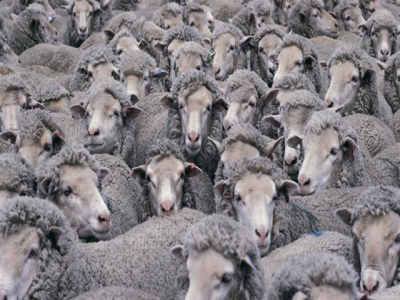Research challenges thinking on lamb survival

Project involves using on-animal sensor technology and blood testing to identify biomarkers that relate to difficult lambing.
New research in Australia is underway to help boost lamb survival in sheep flocks by better understanding the underlying causes of dystocia, or difficulty in lambing, which is one of the costliest conditions for sheep producers, according to an announcement from Meat & Livestock Australia (MLA).
The project is researching the impact the duration of lambing has on ewes and lambs to help better inform future control efforts such as treatments, MLA said.
It is one of 10 projects to be funded by the Strategic Partnership for Animal Welfare Research, Development & Adoption, which is a collaboration between MLA, through the MLA Donor Co., and some of Australia’s leading research bodies to undertake groundbreaking projects focused on animal welfare.
MLA program manager health welfare and biosecurity Dr. Johann Schröder said MLA has identified neonatal lamb loss as one of the top five conditions or diseases compromising sheep profitability and is estimated to cost the industry in excess of $219 million (Australian) annually.
The four-year project is being led by Dr. Sabine Schmoelzl with the Commonwealth Scientific & Industrial Research Organization in Armidale, Australia, who said it will help establish a better understanding of why lambs don’t survive or why ewes fail to raise the lambs.
"Dystocia is defined as ‘prolonged lambing’ or any reason a labor doesn’t progress, including when a ewe is running out of energy and just can’t handle it anymore. We believe dystocia contributes to more than half of all neonatal lamb mortality, which is the single highest cause of financial loss in the sheep industry,” Schmoelzl said.
“This project is developing a completely new research tool to help define what affects the duration of lambing," Schmoelzl added. "We want to be able to answer the question: How can we prevent prolonged lambing by various treatments or through genetics?
“Natural selection of the fittest lambs, or genetic selection of ewes that are successfully rearing lambs, is an attractive concept and important to keep in mind," she said. "Relying on it alone, even with good management, has nevertheless not achieved solving the issue of lamb mortality altogether, and that is why we are developing this new tool.”
Now in its second year, the project has already collected data on 400 ewes during lambing. They are comprised of Merino ewes of different ages, crossed to either Merino or Border Leicester sires, MLA said.
The project’s in-field research involves using on-animal sensor technology — with ewes wearing sensor collars — combined with blood testing to identify biomarkers that relate to difficult lambing.
“We bring ewes in groups of 20 at a time into smaller paddocks to allow them to display normal behaviors during lambing,” Schmoelzl explained. “Being able to keep a watch on lambing ewes on scale and out in paddock conditions rather than a small number of intensely monitored animals will make a big difference.
“We deploy the sensors and have cameras in the paddocks with day and night vision. The video streams are collected, and whenever a lamb is born, we use that footage to observe the behaviors of the ewe and match it with the data that the sensors collect," she added. “We also have a blood analyzer that can be used pen-side to collect blood parameters from the ewes and lambs after birth. We want to find out if can we find biomarkers to measure the metabolic status of the ewe that relates to having undergone a difficult labor.”
Schmoelzl said the research is building on evidence and years of data sourced largely from the Sheep CRC Information Nucleus Flock.
“Over four years, every lamb that was found dead in that flock was analyzed in an autopsy, and they also looked at brain damage. From these data, it was quite clear that in at least half of all lambs that died, there were signs of birth-related injury, and that means birth trauma. It’s quite important to understand what the underlying reasons are when lambs are abandoned by ewes,” Schmoelzl said.
“We think these lambs may get abandoned because they had some birth-related injury. This may mean they were not behaving properly, were a bit slow or couldn’t bleat properly, and the mum couldn’t form the necessary ewe/lamb bond. Also, if there was a difficult labor, then the ewe will also have had trauma and is probably exhausted and unable to immediately bond with that lamb," she explained. “It’s basically moving away from saying some ewes are bad mothers to saying that some ewes have a poor lambing event, and they will overcome that if they are given a chance.”
Có thể bạn quan tâm
Phần mềm

Phối trộn thức ăn chăn nuôi

Pha dung dịch thủy canh

Định mức cho tôm ăn

Phối trộn phân bón NPK

Xác định tỷ lệ tôm sống

Chuyển đổi đơn vị phân bón

Xác định công suất sục khí

Chuyển đổi đơn vị tôm

Tính diện tích nhà kính

Tính thể tích ao hồ




 Genetic study to target bovine babesiosis in cattle
Genetic study to target bovine babesiosis in cattle  Changing manure management could significantly reduce dairy methane…
Changing manure management could significantly reduce dairy methane…